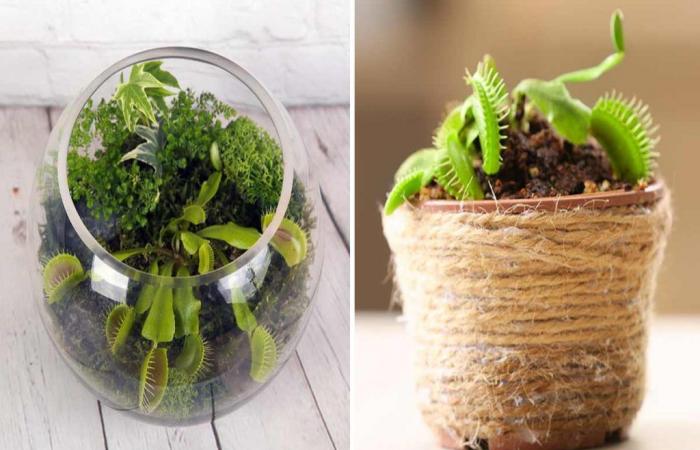Carnivorous plants are not only fascinating because of their rarity, but also offer an exotic decorative element for any home environment.
Often perceived as a mere exotic ornament or conversation piece, carnivorous plants offer much more. These particular species not only purify the air but add a touch of mystery and natural beauty to your home. With a variety of shapes, colors and insect-catching methods, these plants can transform any space into a small ecosystem.
Unique characteristics of carnivorous plants
The carnivorous plants represent an exceptional category unique in the plant kingdom, thanks to theirs ability to capture and digest insects and small animals. These plants have adapted to survive in hostile environmentswhere the soil is deficient in crucial nutrients like theof nitrogen, typically scarce in marshy areas or sandy soils. Their ability to supplement the diet through insect digestion it’s not just a magnificent evolutionary adaptationbut it also proves useful for control insects in domestic environments.
Each species of carnivorous plant has developed a sophisticated capture systemwhich varies from adhesive leaves which trap insects spectacularly quick closure of the traps of the Venus flytrap. These ingenious mechanisms They attract not only prey, but also theinterest of botanists and plant enthusiasts Worldwide. Their presence in the home offers a element of natural wondertransforming every space into a small living ecosystem that inspires curiosity and admiration. The ability of these plants to adapt and thrive offers a clear example of how the nature overcomes obstacles through innovation and specialization.
Dionaea Muscipula: the perfect trap
The Dionaea Muscipulabetter known as Venus Flytrapis probably the most famous of all carnivorous plants. Native to the swamps of the North and South Carolina In the United States, this plant is renowned for its mouth-shaped traps, equipped with small “teeth” and sensitive hairs that, when touched, cause the lightning fast closure of the trap, trapping the insect inside. The Dionaea are not only spectacular to be observed during the capture of prey, but they are also relatively easy to grow at home, as long as they receive enough direct sunlight and are maintained humid with water poor in minerals. Their speed of action and the precision in capturing the prey makes them particularly interesting for those who love them natural solutions against harmful insects. Furthermore, their ability to adapt to different domestic environments makes them anideal addition for lovers of exotic plants.
Drosera Capensis: The Adhesive Beauty
Moving on to another type of carnivorous plant, the Drosera Capensis it is fascinating for its long red tentacles covered in adhesive drops that shine in the light. These drops, while beautiful, are mortals for the insects who, attracted by their luminous appearance, remain glued to them. Drosera is native to Sud Africa and requires an environment hot and wetideal for growing in well-lit domestic environments or in a terrarium, where it can be admired up close. This plant not only adds a touch of color lively with its unique tentacles, but also functions as a effective natural deterrent against insects. Its ability to adapt to different light conditions makes it particularly versatile and appreciated by collectors of exotic plants.
Nepenthes: The Architect of the Rainforest
Among the most exotic carnivorous plants, the Nepenthes it is distinguished by its ampoule-shaped traps. Originally from Asian tropical foreststhis plant uses sweet nectar to lure insects to the opening of the trap. Once inside, the smooth, slippery surfaces of the traps prevent insects from escaping, causing them to fall into a digestive fluid. Nepenthes requires conditions similar to those of its natural habitatwith high humidity and consistently high temperatures, making it an ideal choice for a tropical terrarium. His unique structure and the method of capture make Nepenthes a point of interest not only botanically but also decoratively. In addition to this, the ability of these plants to adapt to domestic environments strengthens their appeal as natural and living furnishing elements.
Sarracenia Purpurea: the song of nectar
Finally, the Sarracenia Purpurea, known for its passive trapping method, uses nectar to lure insects into its funnel-shaped traps. The prey are sedated by the narcotizing nectar, then slide down into the plant’s calyx where they will be digested. This species, native to Nord Americais particularly hardy and can be grown both indoors and outdoors, as long as conditions do not get too cold. It offers an option robust and charming for those who want to start with carnivorous plants. His ability to survive in a wide range of temperatures makes it suitable for many gardens and domestic environments. Furthermore, his unique aesthetic appearance It contributes greatly to the visual appeal of any space, adding a touch of wild and mysterious nature.
Biodiversity at home with carnivorous plants
Carnivorous plants are more than just natural curiosities; they are sophisticated organisms that can enrich the biodiversity of your home. By growing them, you will not only contribute to the health of your home environment, but you will also have the opportunity to observe some of the survival strategies nature’s most ingenious. If you’re looking for a touch of the exotic and a little extra greenery in your home, consider adding one of these fascinating species to your collection. Integrate these plants in your home habitat can also stimulate greater ecological awareness and interest in environmental conservation.
Every carnivorous plant you add contributes to a micro ecosystembringing interesting and educational dynamics into your everyday living space.
Photo © stock.adobe
Follow Castelli News on






